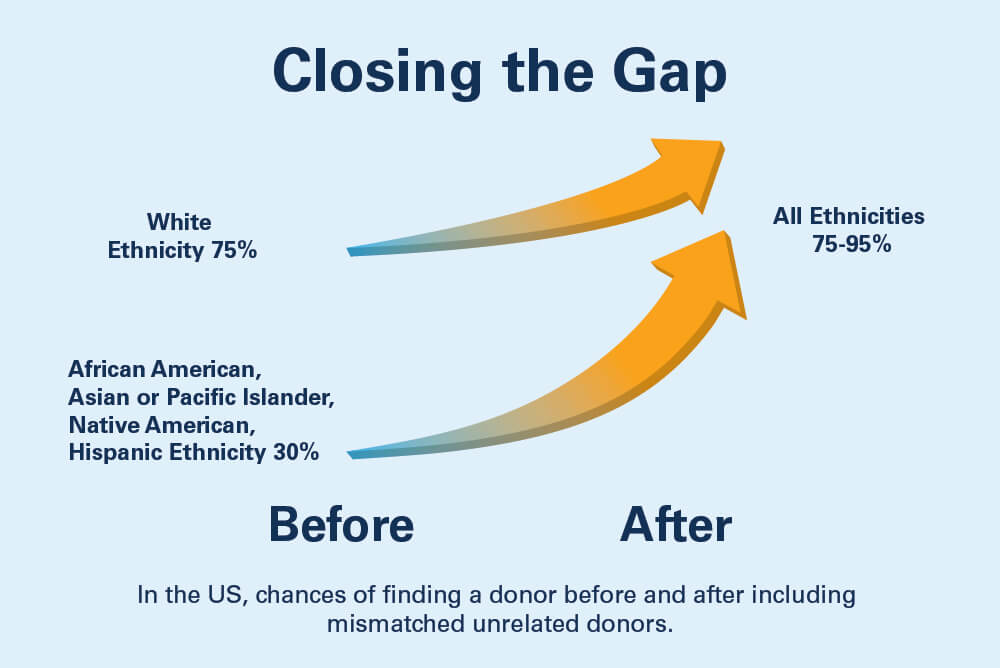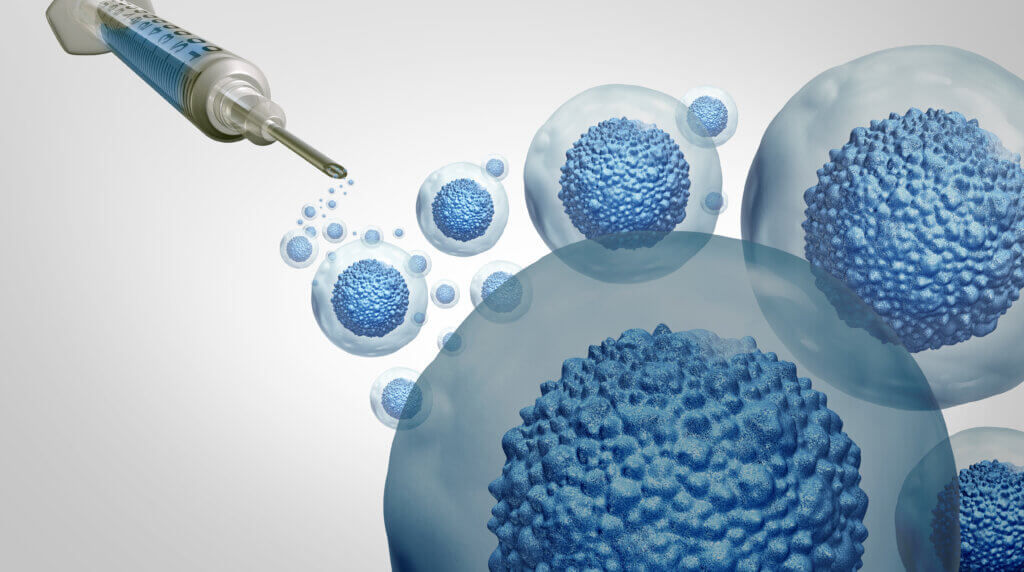- New stem cell transplant methods using mismatched donors and post-transplant cyclophosphamide significantly improve access and outcomes, particularly for underrepresented ethnic groups.
- Post-transplant cyclophosphamide allows for safe transplants with seven-of-eight HLA matches, expanding donor availability to 75-95% for patients of all ethnicities.
- These advancements reduce disparities in donor access, ensuring better treatment options for patients of diverse backgrounds with blood cancers or hematologic conditions.
A white patient looking for a stem cell donor has about a 75% chance of finding a fully-matched unrelated donor in the U.S. NMDP Registry. A fully matched donor has the same human leukocyte antigen (HLA) type, a set of eight genetic variables that dictate how the immune system communicates.
Finding a fully matched donor has been a key strategy to improving stem cell transplant outcomes through successful engraftment and reducing the chance of graft-versus-host disease or reactions between the donor and recipient immune systems. Anything less than an eight-of-eight match has traditionally led to poorer outcomes in allotransplantation, transplantation that involves a donor and not the patient’s own cells.
This strategy, however, hasn’t served everyone equally.
For a person of any other ethnicity – African American, Hispanic, Asian, Pacific Islander, or Native American – the chance of finding a full match is closer to 30 to 40%. HLA types are inherited, so a full HLA match will be more likely with a donor of similar ancestry, but not all ancestries are equitably represented on the registry. As a result, patients of non-Caucasian ancestries often do not find a donor in a timely fashion or end up with a sub-optimal donor and poorer outcomes post-transplant.

Now, however, a study led by Dana-Farber’s Mahasweta Gooptu, MD, a physician in the Adult Stem Cell Transplant Program, suggests that a mismatched unrelated donor can be used safely and achieve the same outcomes as a fully-matched donor with two conditions. First, seven of the eight HLA variables, which are gene variants called alleles, must be matched. And second, a novel strategy called post-transplant cyclophosphamide (PTCy) should be used with infusion of cyclophosphamide following infusion of the stem-cell graft to reduce donor recipient immune reactions.
With this novel approach, survival and toxicities are identical to those with a full HLA match even if a mismatched donor with seven of eight matched alleles is used. This approach increases the probability of finding a donor to 75 to 95% for any ethnicity. This could dramatically improve the ability for people to safely access hematopoietic stem cell transplants, which offer the potential for a cure or longer disease-free survival to people with blood cancers or other hematologic conditions like sickle-cell disease.
“That’s a big deal,” says Gooptu. “There’s a match for everyone now.”
An evolution of matches and medicine
Cyclophosphamide is one of the oldest chemotherapies used by oncologists. It is inexpensive and available in most countries.
“This is the beauty of post-transplant cyclophosphamide,” says Gooptu. “Every oncologist in the world knows how to use cyclophosphamide and has access to it.”

The drug was first used in donor transplants in 2009 for patients with half-match related donors, called haploidentical donors. A haploidentical related donor is a sibling, parent, or offspring who has four of eight HLA alleles matched, which increases the risk of the patient developing graft vs. host disease (GVHD), a condition where the patient’s immune system sees the donor cells as invaders and rejects them. GVHD is one of the chief complications of donor transplants.
Post-transplant cyclophosphamide, given to a patient in two doses following infusion of the stem-cell graft, suppresses immune cells called T cells that are activated and surge in response to the detection of unfamiliar markers, called antigens, on the transplanted cells. The suppression, however, is short-lived and limited, and gives the graft a chance to succeed. Side effects include a slightly higher risk of infection and graft dysfunction but do not alter the toxicity profile of the strategy significantly.
This initial use of post-transplant cyclophosphamide in haploidentical transplants reduced the likelihood of graft vs. host disease, and improved survival. By 2012, the practice had expanded to fully matched, unrelated donors, an option that is facilitated by donor registries, which are established globally.
In 2021, the first study to show that post-transplant cyclophosphamide improved the outcomes of stem cell transplants with mismatched unrelated donors was completed.
“It’s taken 20 years for this platform to move from the haploidentical space to matched and then mismatched unrelated donors,” says Gooptu.
An accumulation of evidence
The 2021 study reported good outcomes for stem cell transplants from donors with not just seven of eight matched alleles but also in a small number of patients with six, five, and even four of eight matched alleles with post-transplant cyclophosphamide. But the study was a single-arm study, meaning the results couldn’t be compared to the option of selecting a matched, unrelated donor.
“We wanted to know if mismatched, unrelated donors were just as good as fully matched donors with this new PTCy strategy,” says Gooptu.
To make this comparison, Gooptu and colleagues did a retrospective study using data from the Center for International Blood and Marrow Transplant Research database. She and her colleagues analyzed results from more than 10,000 patients who had received blood stem cell transplants between 2017 and 2021. The database contained many different donor options and treatment protocols.
The team found that when post-transplant cyclophosphamide was used, there was no difference between matched or mismatched (with seven of eight matched alleles) unrelated donors for patients.
“There is no difference in overall survival, relapse, non-relapse mortality, none of these are worse with the mismatched donor if you used post-transplant cyclophosphamide,” says Gooptu. “This also effectively means that patients of every ethnicity will now have a donor option that will result in outcomes similar to those achieved with a fully matched donor and addresses a long-standing disparity in the field.”
Dana-Farber’s team switched to using post-transplant cyclophosphamide with seven of eight matched unrelated donors in 2021, at first as part of clinical trials and more recently as a standard practice.
For next steps, the team is focused on reducing the side effects of post-transplant cyclophosphamide and improving outcomes even more, potentially with lower doses or combinations with other agents.
About the Medical Reviewer

Dr. Gooptu attended medical school at Kolkata Medical College in India, followed by a residency at Albert Einstein Medical College and fellowship at Thomas Jefferson University. She completed an advanced fellowship in adult hematopoietic stem cell transplantation at Dana-Farber Cancer Institute and is currently an attending physician in the adult SCT division. Dr. Gooptu's research interests include post-transplantation immune reconstitution, haploidentical transplantation and autologous transplantation for severe autoimmune disorders
